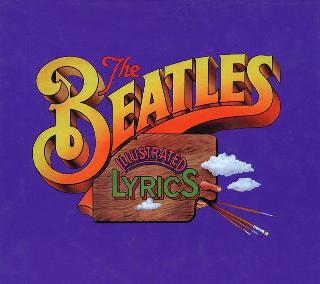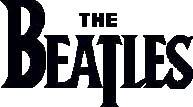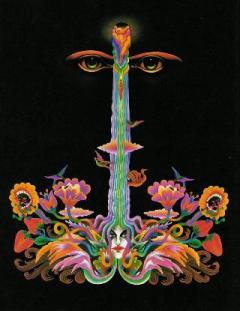

 (c) Alan Aldrigde, The Beatles Illustrated Lyrics
(c) Alan Aldrigde, The Beatles Illustrated LyricsGENERAL POINTS OF INTEREST
- For us listeners, the use of cover songs by The Beatles as "filler" was wearing out its welcome by this point, but it was also something on which they thankfully would never have to rely upon again; with the exception, of course, of their arrangement of the "traditional" "Maggie Mae" for _Let It Be_, but that's another story altogether.
- The three songs in the current group still do play some role in stylistically rounding out the collections of which they are a part; it would be an overstatement to describe them as the musical equivalent of styrofoam peanuts. "Act Naturally" both resonates with, and extends, the gesture that the group had already made in the direction of folk rock. It also fits perfectly within the already well established pattern of handing off novelty songs to Ringo. The two Larry Williams songs provide a double shot of plain old hard rock-and-roll the likes of which the Beatles own originals on these albums had already grown beyond in sophistication of vocabulary and ethos.
- The two Williams numbers had been a part of the pre-Beatles repertoire as early as the period of '60 - '62. They then disappeared from it during the major concertizing heydays of '63 - '64, with "Dizzy Miss Lizzy" resurrected for the '65 season, but "Bad Boy" reappearing only for its use on the American "Beatles VI album." "Act Naturally" appears to have been added to their set list specifically in '65.
SONG-BY-SONG WALKTHROUGH
KEY G Major
METER 4/4
FORM
Intro -> Verse -> Bridge -> Verse -> Break (intro) -> Verse -> Bridge -> Verse -> Outro (w/complete ending)
COMPOSER Russell/Morrison
INFLUENTIAL VERSION Buck Owens (1963)
- This Rockabilly entry goes much further down the "coontryish" path than any Beatles original had to-date but it works in context, due in large part to Ringo's unvarnished vocal which sounds astonishingly similar in treatment to the Buck Owens original.
- The music is built on a sturdy and frugal set of chords limited to just I, IV, V, and V-of-V; the latter held back for strategic deployment at the end of the bridge. The arrangement is characterized by a recurrent obbligato for the low strings of the guitar (w/low E tuned down to D!) and the tapping of drumsticks.
- Beyond the lead vocal, the Beatles version matches the original in many other respects including same key, same basic arrangement right down to the tapping, and the backing vocal part for the bridges.
- There are some differences, as well, the most significant of which affects the form: the music used by the Beatles for Intro/Outro/and Break appears in the original only for the break and even there it is used in abbreviated form. At the detailed level, the original uses a boogie-like arpeggio bassline for the bridge while the Beatles stay with the oompah figuration used in the verse. Paul continues the backing vocal into the final verse whereas the original omits it. And, for those more or less exclusively acquainted with the Beatles version, the different scanning of the words by Owens sounds somehow "wrong" at first.
KEY C Major
METER 4/4
FORM
- 2X -
Intro -> Verse -> Break -> Verse (w/complete ending)
COMPOSER Williams
INFLUENTIAL VERSION Larry Williams (1959)
- The common wisdom on this as a cover choice by the Beatles is that it was aimed in particular at The American Audience, as if somehow the humor contained therein night be found incomprehensible on the other side of the pond. Granted, the amusingly disruptive behavior described in this song as somehow traceable to an unhealthy preoccupation with rock-and-roll is admittedly as American as almost any song by the Coasters. But I'm just a tad skeptical that we could have possibly had some kind of monopoly on this relatively benign strain of juvenile deliquency :-).
- To be sure, this is compositionally a very typical song of Mr. Williams and it bears some direct comparison with his "Slow Down" (SD), also covered by Our Own Sweet Boys on the _Long Tall Sally_ EP; see the earlier Notes on LTSEP. With SD we found a bloated, twice-as-slow 24-bar variant on the 12-bar blues form. Here in "Bad Boy" the variation is a bit more interesting: a 20-measure form in which the final, suddenly heavily syncopated phrase reverts to the strict 4 measures instead of being doubled up to eight. Note, by the way, how the Break section is a strict 12-bar frame!
- The Beatles version features a nice *single*-tracked vocal by John, equally nice lead guitar work that mimics the original suprisingly closely by George, and the inevitable rhythmic shaking of a tambourine. The form matches the original, but as you might expect differences abound at the detailed level.
- The original (by the composer, himself, of course!) sounds as though backed by an ensemble the size of a small stage band, dominated by the sounds of piano and saxophone. Williams sings it in the slightly lower key of B-flat, and the vocal arrangement features the relentlessly kitschy, not to say judgmental, recitation of "he's a bad boy!" between every single line of the lead vocal.
KEY A Major
METER 4/4
FORM
- 2X - --------- 2X -------- Intro -> Verse -> Verse (solo) -> Verse -> Verse (w/complete ending)
COMPOSERS Williams
INFLUENTIAL VERSION Larry Williams (1958)
- This Williams song is of the genre in which every single section is in the strict 12-bar format. Indeed, no Beatles album to this point would be complete without at least one example of this kind. Here, the distinctive feature is the bluesy lead guitar ostinato figure used as solo material in the intro and Break and as an obbligato in all the verses.
- John is double-tracked throughout this time and seems to be busting out all together with various "oohs" and "ows" which are not very much in evidence on the original; perhaps he was getting mixed up between this song and the previous one, the original of which *does* have the lead singer thus expostulating. The reverb that seems to have been gratuitously added to the CD remix of this track is among the more infamous "recording anomolies" of the Beatles annals.
- It turns out that the Beatles tamper with the form of the original, adding a second instrumental break section and a final repeat of the fever" verse.
- Though a boogie-woogie piano part figures prominently in both versions, the original again has more of a stage band sound than the less-is- gutsier sound of the Beatles. Williams performs yet again in B-flat and he inconsistently sustains the I chord in measure 12 of some of the frames instead of always shifting to V as the Beatles do.
- The lead vocal of the both Williams originals has a restrained and melifluous quality that will no likely come as a surprise to those familiar with only the Beatles covers. Alas, the Beatles of the mid '60s would seem from our politically correct vantage point to have labored under the uneccessary, even misguided presentiment that it was a virtue for a white singer, in performing the works of a black artist, to resort to raspy shouting in order to hit the mark. I have to call them as I see them, and this foible would seem to be as common to Paul's evocations of Richard Penniman as it was to John's of not only Williams, but also Berry and even Robinson. This is not to say that such Beatles covers are entirely without either merit or success, but I'd dare say that on some level they sound a bit more parodistic and less interpretive than intended.
SOME FINAL THOUGHTS
- With this Note we've completed our studies of the Beatles officially recorded canon from "Love Me Do" up through the end of the _Help_ and _Beatles VI_ albums, including all singles of the period.
- Next time we move on to tackle the songs of _Rubber Soul_ and beyond.
Regards,
Alan (awp@bitstream.com *OR* uunet!huxley!awp)
---
"Have you no natural resources of your own ?" 020892#76
---